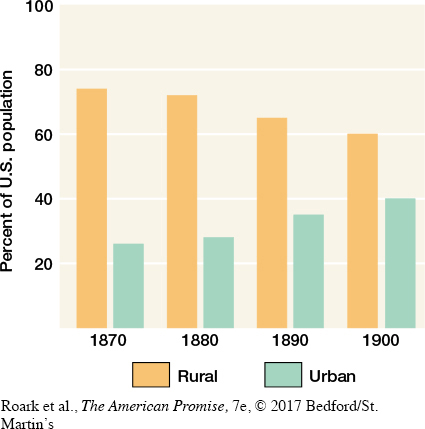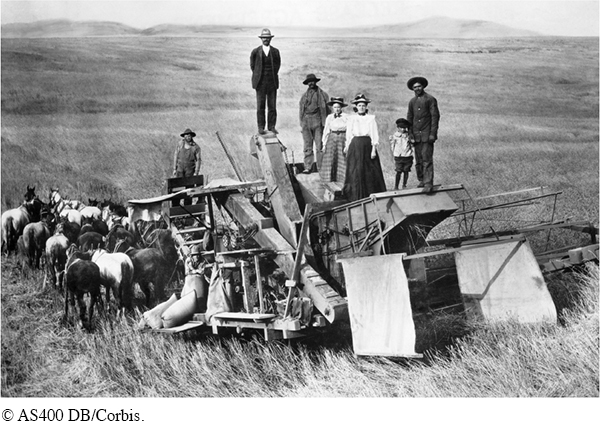The American Promise: Printed Page 493
The American Promise, Value Edition: Printed Page 450
The American Promise: A Concise History: Printed Page 513
Commercial Farming and Industrial Cowboys

In the late nineteenth century, the population of the United States remained overwhelmingly rural. The 1870 census showed that nearly 80 percent of the nation’s people lived on farms and in villages of fewer than 8,000 inhabitants. By 1900, the figure had dropped to 60 percent (Figure 17.1). At the same time, the number of farms rose. Rapid growth in the West increased the number of farms from 2 million in 1860 to more than 5.7 million in 1900.
New technology and farming techniques revolutionized American farm life. Mechanized farm machinery halved the time and labor cost of production and made it possible to cultivate vast tracts of land. Meanwhile, urbanization provided farmers with expanding markets for their produce, and railroads carried crops to markets thousands of miles away. Even before the start of the twentieth century, American agriculture had entered the era of what would come to be called agribusiness—
As farming moved onto the prairies and plains, mechanization took command. Steel plows, reapers, mowers, harrows, seed drills, combines, and threshers replaced human muscle. Horse-

The American Promise: Printed Page 493
The American Promise, Value Edition: Printed Page 450
The American Promise: A Concise History: Printed Page 513
Page 494Like cotton farmers in the South, western grain and livestock farmers increasingly depended on foreign markets for their livelihood. A fall in global market prices meant that a farmer’s entire harvest went to pay off debts. In the depression that followed the panic of 1893, many heavily mortgaged farmers lost their land to creditors. As a Texas cotton farmer complained, “By the time the World Gets their Liveing out of the Farmer as we have to Feed the World, we the Farmer has nothing Left but a Bear Hard Liveing.” Commercial farming, along with mining, represented another way in which the West developed its own brand of industrialism. The far West’s industrial economy sprang initially from California gold and the vast territory that came under American control following the Mexican-
Two German immigrants, Henry Miller and Charles Lux, pioneered the West’s mix of agriculture and industrialism. Beginning as meat wholesalers, Miller and Lux quickly expanded their business to encompass cattle, land, and land reclamation projects such as dams and irrigation systems. With a labor force of migrant workers, a highly coordinated corporate system, and large sums of investment capital, the firm of Miller & Lux became one of America’s industrial behemoths. Eventually, these “industrial cowboys” grazed a herd of 100,000 cattle on 1.25 million acres of company land in California, Oregon, and Nevada and employed more than 1,200 migrant laborers on their corporate ranches. Miller & Lux dealt with the labor problem by offering free meals to migratory workers, thus keeping wages low while winning goodwill among an army of unemployed who competed for the work. When the company’s Chinese cooks rebelled at washing all the dishes, the migrant laborers were forced to eat off dirty plates. By the 1890s, more than 800 migrants a year followed what came to be known as the “Dirty Plate Route” on Miller & Lux ranches throughout California.
The American Promise: Printed Page 493
The American Promise, Value Edition: Printed Page 450
The American Promise: A Concise History: Printed Page 513
Page 495Since the days of Thomas Jefferson, agrarian life had been linked with the highest ideals of a democratic society. Agrarianism had been transformed. The farmer was no longer a self-